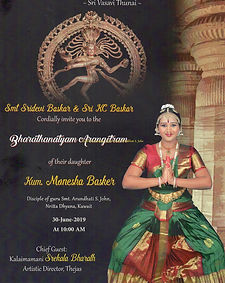All About Arangetram

Bharatanatyam Arangetram is a milestone in the journey of a dancer, marking their debut performance. It's a culmination of years of rigorous training in this classical Indian dance form, showcasing intricate footwork, graceful expressions, and captivating storytelling on stage.
Bharatanatyam, often referred to as the "Fifth Veda" and the embodiment of India's rich cultural heritage, is a classical Indian dance form that has captivated audiences worldwide for centuries. Rooted in the sacred texts and temple traditions of southern India, Bharatanatyam is characterized by its intricate footwork, expressive storytelling, and graceful movements that seamlessly blend rhythm, melody, and emotion. It is not merely a dance but a holistic art form that transcends physical expression to communicate profound narratives and spiritual themes.
At the heart of a Bharatanatyam dancer's journey lies a pivotal moment, a rite of passage known as the Arangetram. This traditional debut performance marks the culmination of years of rigorous training, discipline, and dedication. It represents the blossoming of a dancer's skills, creativity, and understanding of the art form. In this article, we delve into the depths of the Bharatanatyam Arangetram, exploring its significance, preparation, and the enchantment it brings to the world of classical dance.
Arangetram: The Confluence of Artistry and Tradition
The term "Arangetram" finds its roots in the Tamil language, where "Arangu" means stage, and "Ettam" means rising. Essentially, it signifies the ascent to the stage, a momentous step in a dancer's journey. The Arangetram is not just a dance recital; it is a holistic experience, a spiritual journey, and a cultural celebration rolled into one.

Bharatanatyam, often referred to as the "Fifth Veda" and the embodiment of India's rich cultural heritage, is a classical Indian dance form that has captivated audiences worldwide for centuries. Rooted in the sacred texts and temple traditions of southern India, Bharatanatyam is characterized by its intricate footwork, expressive storytelling, and graceful movements that seamlessly blend rhythm, melody, and emotion. It is not merely a dance but a holistic art form that transcends physical expression to communicate profound narratives and spiritual themes.
At the heart of a Bharatanatyam dancer's journey lies a pivotal moment, a rite of passage known as the Arangetram. This traditional debut performance marks the culmination of years of rigorous training, discipline, and dedication. It represents the blossoming of a dancer's skills, creativity, and understanding of the art form. In this article, we delve into the depths of the Bharatanatyam Arangetram, exploring its significance, preparation, and the enchantment it brings to the world of classical dance.
Arangetram: The Confluence of Artistry and Tradition
The term "Arangetram" finds its roots in the Tamil language, where "Arangu" means stage, and "Ettam" means rising. Essentially, it signifies the ascent to the stage, a momentous step in a dancer's journey. The Arangetram is not just a dance recital; it is a holistic experience, a spiritual journey, and a cultural celebration rolled into one.
The Journey

The Bharatanatyam Arangetram journey is a transformative odyssey for dancers, encompassing years of dedicated practice, mastering intricate movements, expressions, and storytelling. It culminates in a mesmerizing debut performance, celebrating the artist's artistic growth and proficiency. Apart from The Bharatanatyam dance performance which consist of six portions: Alarippu, Jathiswaram, Shabdam, Varnam, Padam, and Tillana, Let us explore the other stages involved in this journey.
Margam

According to the great legendary dancer T.S.Balasaraswati, “The traditional order of the BharatNatyam- alarippu, jatiswaram, shabdam, varnam, padam, tillana and shloka or verse, is the correct sequence for revealing the spiritual through the corporeal.”

(Meaning – In praise of a Hindu Deity. This is the opening piece in which the dancer offers respects to the lord, teacher and the audience and (s)he does Namaskaram).
Min
Planning on doing your Arangetram?
Ready to take the stage for your Bharatanatyam Arangetram? Reach out to us for expert guidance and seamless assistance




















